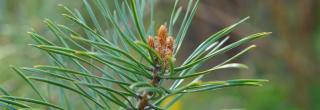

A mystical tree worshiped in many past civilizations, the Pine tree represents immortality in the Far East due to its long life span and its peculiar sap.
It usually grows atop rocky mounts, in dry and poor soil that are acidic and sandy. The pine tree can grow to gigantic sizes, and its circumference is impressive.
Its spongy bark renews itself and falls off like scales. Needles land on the soil and take a long time to break down, thus preventing underbrush growth.
In this quick overview, this article will reflect which medicinal properties pine tree shares as well as those much appreciated in gastronomy.
All the pine trees belong to the Pinaceae family. “Pine” is the generic, common name for all the trees belonging to the “Pinus“ genus. There are at least 111 different species in this genus. Sometimes it is called “pinewood”. This tree’s name goes back to ancient Greek, Celtic and Sanskrit with the root word “Pitu“ which means “drink” or “food”.
The story of pine goes back a long time.
Indeed, in Japanese culture, cypress and pine trees play a part in specific ritual implements and portions of temples in Shinto beliefs.
As for the Roman empire, the fertility goddess Cybele inspired devotions to pine trees to symbolize eternal renewal in the cycles of Nature.
The famed oriental taoists would have pine seeds, needles and sap as their favorite diet since they said it “made their bodies light and capable of flight”!
In Europe, there are several different pine tree species: maritime pine, Scots pine, Swiss pine, eastern white pine, black pine, Aleppo pine, Pinus uncinata, stone pine, loblolly pine, mugo pine…
But now, what are the properties of this very famous tree?
In North America and in Europe, young growth of Scots pine trees have long been an ingredient to prepare herbal tea. Indeed, its benefits are known to treat:
Century-old traditional medicinal baths are an integral part of what the German people believe in. The hygienist doctor Kneipp used his influence to help medicinal baths become a common treatment for many ailments in Germany.
Indeed, pine tree is particularly recommended to treat diseases resulting from nerve malfunction, neuralgic disorders and rheumatism.
Relaxing in a bathtub with pine tree extracts is for sure beneficial to your health.
To best appreciate its health benefits, keep the least tender shoots from your collection of fresh young shoots, and add them to the hot water. Use a cloth pouch to make it easy to pick the leaves out later and throw them to the compost.
It is possible to bathe in water infused with pine as described above, but inhaling the raw power of a pine tree forest in nature is another experience altogether.
Indeed, if you’ve got the chance, go for a walk in a thick pine tree forest, and gulp the air into your lungs. It is loaded with pine extract, a lemony camphor-like fragrance.
Previously, white pine young stems were very much appreciated in cooking by the Iroquois American Indians. They snacked and ate them raw. This dietary habit was also familiar to the American Indians of British Columbia who would also chew on raw shoots from other pine tree species.
Some have found different ways to cook young pine tree shoots, and when you add them to vegetables at the end of cooking or toss some in mixed salads, their taste will make you ooh and ahh in wonder.
Other prefer to steam those young pine shoots, and serve them after just a few minute’s worth of steaming. Dipped in salad dressing or mustard, it’s delicious!
The edible portions of the pine tree are, among others:
Caution: yew is toxic, though so make sure you know your trees first!
Young stems of pine trees – especially the most tender ones – are very much appreciated in mixed salads. Collect them at the tip of branches, right at the spot where needles haven’t yet grown.
Once harvested, dry the young stems on a cloth or veil with a lot of air circulation. Keep away from moisture and light. When dry, store them in a paper bag, a cardboard box, a glass jar or a metal tin. You can also sow a cloth pouch to store them, too.
To prepare your bathwater, dip the pouch with about 18 oz (500 grams) young pine tree shoots in the water. You can also prepare a concentrated young pine shoot infusion and add that to the bathwater. 2 or 3 quarts or liters are enough to prepare the infusion.
After the bath, it is highly recommended to lay down and relax for about 30 minutes to an hour (at most). Then, resume your daily activities.

Pine needles are also excellent to protect plants that grow in acidic environments, like rhododendron or azaleas. Spread them around those plant’s trunks.
Important: In case of doubt, it is always useful to check with a specialist or ask your consulting physician before opting for a plant-based treatment.